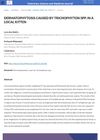1 citations,
August 2016 in “Hanbang an'i'bi'in'hu pibu'gwa haghoeji” YangHyulEum Gami-Bang extract may help treat hair loss.

PCOS has a strong genetic basis, but more research is needed to fully understand it.
1 citations,
December 2013 in “BMJ case reports” A pregnant woman with Werner's syndrome died during childbirth, but her baby survived and did not have the syndrome.
1 citations,
January 2013 Bimatoprost treats glaucoma and promotes hair growth, with potential for more medical uses.
 1 citations,
August 2011 in “Planta Medica”
1 citations,
August 2011 in “Planta Medica” Bimatoprost effectively promotes hair growth.
1 citations,
May 1989 in “JAMA” Minoxidil can help hair growth but may not always look cosmetically good.
 November 2024 in “Research Square (Research Square)”
November 2024 in “Research Square (Research Square)” Moracin M, a compound from the Moraceae family, has been shown to significantly enhance hair growth by promoting cell proliferation and angiogenesis in human dermal papilla cells (hDPCs). The study found that Moracin M activates the Wnt/β-catenin signaling pathway, leading to increased levels of growth factors such as VEGF, FGF2, KGF, HGF, and MYC, similar to the effects of minoxidil. It also enhances cell migration in human umbilical vein endothelial cells (HUVECs) without cytotoxicity at concentrations up to 50 µM. Additionally, Moracin M increases protein and mRNA levels of VEGF, FGF2, and KGF under inflammatory conditions and stimulates MMP-2 and MMP-9 expression, contributing to wound healing. These results suggest that Moracin M could be a promising alternative to current hair growth treatments.

γδTregs may help treat autoimmune diseases like alopecia areata by promoting hair regrowth and reducing immune attacks.
 November 2024 in “International Journal of Cosmetic Science”
November 2024 in “International Journal of Cosmetic Science” The study investigates the potential of botanical extracts to improve scalp conditions by reducing oxidative stress, which affects hair and scalp health. Using both chemical and biological antioxidant mechanisms, 10 botanical extracts were tested for their ability to combat reactive oxygen species (ROS). The study employed ORAC testing, a Nrf-2 cell assay, and a 3D human keratinocyte model to evaluate antioxidant activity. A 4-week consumer study with 56 participants using a leave-on treatment containing a botanical extract showed a reduction in oxidized lipids on the scalp. The results indicate that incorporating botanicals with antioxidant properties into hair and scalp care products can enhance scalp health.
 October 2024 in “Frontiers in Veterinary Science”
October 2024 in “Frontiers in Veterinary Science” FKBP10 and FBN2 are key proteins for hair growth in cashmere goats.
 April 2024 in “Expert opinion on investigational drugs”
April 2024 in “Expert opinion on investigational drugs” JAK inhibitors are safe and effective for treating moderate-to-severe alopecia areata.
 March 2024 in “Tissue engineering. Part A”
March 2024 in “Tissue engineering. Part A” Negative pressure therapy increases hair growth in mice.

The YH complex, made from certain plant extracts, effectively promotes hair regrowth and could be a potential treatment for hair loss.

Baricitinib may effectively treat oral lichen planus.
 December 2023 in “Journal of ethnopharmacology”
December 2023 in “Journal of ethnopharmacology” Tribuloside can increase skin pigmentation by enhancing melanin production and distribution.
 November 2023 in “International Journal of Dermatology”
November 2023 in “International Journal of Dermatology” Patients with central centrifugal cicatricial alopecia often have higher rates of metabolic, autoimmune, and atopic conditions, as well as anxiety and depression.
 November 2023 in “The journal of investigative dermatology/Journal of investigative dermatology”
November 2023 in “The journal of investigative dermatology/Journal of investigative dermatology” Cancer treatment drugs can cause permanent hair loss by damaging hair follicle stem cells, but a specific inhibitor might reverse this effect.
 October 2023 in “Jurnal Ilmu Kesehatan Hewan”
October 2023 in “Jurnal Ilmu Kesehatan Hewan” The kitten's skin condition improved significantly after 4 weeks of treatment.
October 2023 in “Veterinary Science and Medicine Journal” The cat's ear and skin issues improved significantly after 10 days of treatment.
 October 2023 in “IBRO neuroscience reports”
October 2023 in “IBRO neuroscience reports” Rat hair follicle stem cells have functional oxytocin receptors, useful for studying neuropsychiatric disorders.
 October 2023 in “International journal of rheumatic diseases”
October 2023 in “International journal of rheumatic diseases” New treatments targeting the JAK signaling pathway, especially JAK inhibitors, show promise for alopecia areata.
 September 2023 in “Journal of the American Academy of Dermatology”
September 2023 in “Journal of the American Academy of Dermatology” Increased awareness and research are needed to prevent hair loss from cosmetic procedures.
 September 2023 in “Cells tissues organs”
September 2023 in “Cells tissues organs” Mice skin matures by day 200, leading to aging signs like curved hair follicles and white hairs due to changes in skin stem cells.
 September 2023 in “Cureus”
September 2023 in “Cureus” Topical finasteride might be a good alternative for hair loss treatment with fewer side effects, but more research is needed.
 September 2023 in “The Journal of Dermatology”
September 2023 in “The Journal of Dermatology” Bariatric surgery improved many skin conditions in obese patients but caused hair loss in some and decreased facial oil and skin elasticity.
 September 2023 in “Journal of The American Academy of Dermatology”
September 2023 in “Journal of The American Academy of Dermatology” Adolescents with hair loss show different hormone levels by sex and often have related metabolic issues.
 August 2023 in “Medical Hypotheses”
August 2023 in “Medical Hypotheses” Metformin, usually used for diabetes, can also help treat hair loss from alopecia areata due to its ability to reduce inflammation and stimulate new hair growth.
 August 2023 in “Micromachines”
August 2023 in “Micromachines” The new method can create hair follicle-like structures but not complete hair with roots and shafts, needing more improvement.

DNA analysis can help tailor alopecia treatment.
 August 2023 in “Indian journal of pediatrics/Indian Journal of Pediatrics”
August 2023 in “Indian journal of pediatrics/Indian Journal of Pediatrics” Topical treatments helped a child with Down syndrome and severe hair loss regrow most of his hair.
























